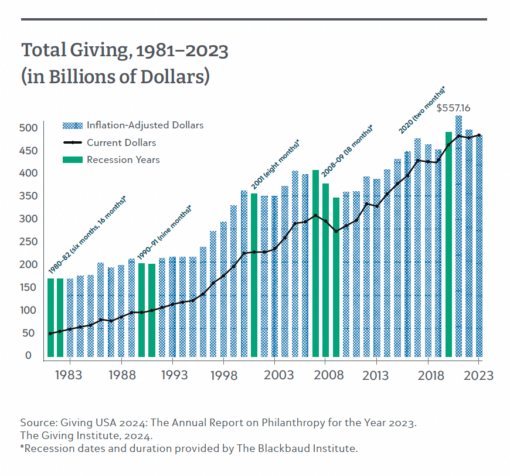How Savvy Organizations Weather Uncertain Times

Preparing for the unknown is a tenant of leadership in today’s ever-changing economic, political, and cultural landscape—and those who know what’s come before are best prepared for what’s ahead. Blackbaud’s research lab has taken a second look at how charitable giving weathers economic storms, and we have good news: despite fluctuating alongside the economy, philanthropy has been largely resilient and has continued an upward trajectory in the last forty years.
Most recessions over the last 40 years have not significantly impacted the sector. Only The Great Recession had lasting effects on charitable giving. But even in this instance, the sector rebounded within 3 years, recovering equivalent giving levels. Total giving has steadily increased over the last four decades, even when adjusted for inflation. When recessions are highlighted, you can see that while the impact is evident, in the long run giving continued to rise.

While the sector is shown to bounce back from economic declines, how can you ensure that your organization is ready to meet the challenge?
Prepare for Tomorrow, Today
Through historical analysis and understanding of recent trends in charitable giving, some key themes emerge that foster resilience. Here are just some examples of how you can continue to proactively future-proof your organization:
- Understand where you are now. When the economy is unpredictable, or everyone is predicting a downturn, it helps to take stock of where you are, what your goals are, and how your priorities are aligned. Getting realigned on your priorities makes the decision process simpler if programs do need to be pulled back or funding needs to be shifted. It’s important to review this information so your team can be proactive in addressing funding issues or increased demand before they happen.
- Create momentum in the short term. When there are storms in the forecast, it makes sense to be prepared. Depending on the last time your organization had to take an intense look at its finances, your financial ducks may already be well- aligned. But it never hurts to review the small ways money flows in and out of your organization. Look for ways to negotiate better rates, find new discounts, and trim unnecessary expenses. Also, fine-tune your income channels to make sure they are revenue-wise.
- Plan for the long term and create a foundation for the future. Given a long enough horizon, nonprofits will experience every economic cycle at least once. The organizations that successfully weather storms look farther than next week or even next year. Short-term adjustments are crucial for surviving economic uncertainty, but to thrive, you need to be prepared for the long-term shifts that will affect your organization. This data-driven approach also helps keep you from organizational inertia. You prune processes that are no longer serving you, even though that is the way it has always been done. Learn more in this Cost Containment Guide for Nonprofit Finance Teams.
- Diversify your revenue mix. Philanthropic organizations follow a multitude of revenue models. While different organizations may thrive using various combinations of revenue sources, organizations should avoid an over-reliance on certain sources. A survey of fundraisers in 2024 illustrated that a diverse revenue mix was one of the greatest determinations of resiliency.
- Embrace digital transformation. From reducing your manual processes through workflow automation and AI tools to thriving in remote working environments and embracing new platforms, organizations must adhere to a new focus on delivering strong digital experiences to their stakeholders.
- Find and target major donors. Data from our Vital Signs series—supported by the 2024 Generosity Commission Report—found that, while the overall amount of dollars donated continues to grow, the number of individuals donating money since the last recession has been shrinking. Organizations should familiarize themselves with their donors on file as well as prospects who have the capacity to make a major gift. Additionally, many major donors search out alternative vehicles for giving and tax benefits to make their philanthropic dollars go further. Organizations should ensure they are prepared to accept non-cash gifts.
- Focus on donor retention. While first-year donor retention remains a challenge among nonprofit organizations, multi-year retention rates remain strong. Marketing and fundraising strategies must be aligned to best frame and communicate the societal values embraced by an organization’s mission and programs.
- Invest in a sustained giving program. Data shows that revenue per donor increases in the years preceding the two years following a donor’s commitment to a sustainer program (50% to 300%, with even the low end far exceeding the typical return for non-sustaining donors). As a strategy choice, there is substantial value to be had in sustainer fundraising.
- Add to your donor pool. Organizations need to focus on strategies that address the changing macroeconomic environment we find ourselves in. To provide the most long-term growth, organizations must continually add to their pool of donors. Recent Blackbaud Institute research into Gen Z giving behaviors, as well as spontaneous donor retention, illustrates the value of laying groundwork today for a wider, more engaged donor pool tomorrow.
- Harness the power of peer-to-peer fundraising. The acceleration of avenues like crowdfunding, do-it-yourself, and peer-to-peer fundraising will continue to be a cohesive component of overall fundraising strategies. Speaking to individuals on a one-to-one versus a one-to-many level, these campaigns continue to gain traction, connecting people to the causes they care about through the channels they regularly use.
Digital Maturity May Hold the Key
A recent survey of nonprofit and education fundraisers from the Blackbaud Institute revealed a strong correlation between digital maturity and revenue success. A digitally mature organization is defined as one in which technologies are integrated across all areas, including fundraising, service delivery, supporter/student experience, and internal processes. Twice as many digitally mature organizations claimed to be getting the most out of their tech investment than those who classified themselves as digitally limited. Those who are digitally limited are also less likely to have experienced revenue growth.
As the last few years have shown us, change is here to stay and can promote more critical and nimble approaches to fundraising and donor management. Incremental investment into growth, using the tips above, can drive your organization towards a more resilient, tech-savvy future. Embracing the future of fundraising—using AI tools to sharpen your engagement strategies, pinpoint high-potential donors, and reduce staff burnout—can give you the edge you need to weather uncertain times.


